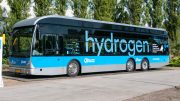As Europe moves towards net-zero emissions, policymakers are looking at all available sources of energy, including new low-carbon gases like hydrogen, to decarbonise at least cost. But direct electrification – of transport, industry and buildings – remains the top priority for the European Commission.
The EU’s aspiration to reach climate neutrality by 2050 means “increased ambition” to cut emissions in the short term, said Paula Abreu Marques, a senior official at the European Commission’s energy department.
That means making the most of all available sources of energy in order to reduce emissions as quickly as possible across all sectors of the economy.
Scientists have warned that time is running short to contain global warming “well below 2°C” and as close as possible to 1.5°C, the main objective of the Paris Agreement. And getting there implies peaking global emissions as early as possible in the 2020s, according to the Intergovernmental Panel on Climate Change (IPCC), a UN body.
“More and more we see sector coupling and sector integration at the core of this debate,” Marques told a EURACTIV event earlier this month, saying the new Commission headed by Ursula von der Leyen “will do a lot about it in the next five years.”
Sector coupling has become a buzzword in Brussels. Simply put, it means linking together electricity and gas networks in order to decarbonise at least cost energy-hungry sectors such as transport, buildings, industry and even agriculture.
Speaking at the EURACTIV event, Marques clarified what the Commission means by sector coupling and sector integration.
“For us, sector integration is the way we are linking the various components of the energy system,” Marques said.
“And the first component is direct electrification” – in buildings, industry and transport – she told participants at the event, organised with support from Spanish energy utility firm Iberdrola.
Indirect electrification
The second component, she said, is “indirect electrification” where excess renewable power from wind and solar is used to produce low-carbon fuels like hydrogen, which can then be used for heavy-duty transport and energy-intensive industries like steel and cement.
A third aspect is circular economy, where waste gases from industry and excess heat from data centres are captured and used for heating homes and businesses, Marques said.
“And last but not least, the fourth component is linking all the dots,” the official said. This includes interconnecting distribution and transmission grids, as well as enabling “reverse flows” in gas and heat networks in order to allow the injection of locally-sourced biomethane and other waste gases into the grid, she explained.
And for the European Commission, the connection of electricity and gas networks – sector coupling – is a key enabler of all this, Marques said.
“This is very important. Why? Because it allows decarbonising sectors that are difficult to decarbonise,” she explained, saying the rise of cheap wind and solar power makes it “easier for electricity to decarbonise” sectors like heating, buildings, industry and even agriculture.
Moreover, coupling electricity with gas helps prevent “oversized infrastructure” growth in power networks, which the Commission said will form the backbone of Europe’s low-carbon energy system by 2050.
An often-cited example is excess electricity produced by offshore wind farms, which can be transformed into hydrogen via electrolysis and subsequently stored in the gas network.
“We will hear a lot about this in the coming years, starting with the European Green Deal that will be presented in the first hundred days of the new Commission,” Marques said.
Hydrogen is “the glue”
Calls to improve gas and electricity interconnections are also driven by the move towards a more decentralised energy system, where consumers and small businesses are becoming producers of energy.
That means connecting local producers of renewable electricity and biomethane to the grid, in order to minimise the need for expanding large-scale transmission networks.
The gas industry has talked up the potential of biomethane and hydrogen as a key enabler of the energy transition, saying new low-carbon gases can easily be stored in the existing gas infrastructure, and used at times of peak electricity demand, thereby minimising the cost of decarbonisation.
“Hydrogen is the glue to bring all of those sectors together,” said James Watson, secretary-general of Eurogas, a trade organisation.
The European Commission has heeded those calls, saying hydrogen will play a “pivotal role” to decarbonise energy because it helps fill the “shortcoming” of electricity networks.
“All cannot be electrified, that’s true,” said Ville Niinistö, a Finnish MEP from the Greens group in the European Parliament. “But we have to remember that energy coupling is about getting rid of fossil fuels as fast as possible. It’s not about giving fossil gas more time,” he told participants at the EURACTIV event.
Niinistö’s point reflects strong scepticism among environmentalists that industry talk about “green gas” and sector coupling is just that – talk.
“Sector coupling is not an aim in itself,” said Lisa Fischer from climate think tank E3G. “We need to remind ourselves why we are doing this – and that is decarbonisation,” she added. “We need to keep our eyes on the ball.”
Renewable power “most efficient and competitive”
Energy firm Iberdrola wouldn’t disagree. Although the electricity and gas sectors have a lot to gain from joining forces, sector coupling also has its limits, said Elena León Muñoz, regulatory director at the Spanish utility.
“Electricity based on renewables is the most efficient and competitive way to decarbonise energy at the moment,” Muñoz told the audience at the EURACTIV event. “And this is a fact, not an opinion,” she stressed.
Renewables are now the cheapest form of electricity, with costs around or even below wholesale electricity prices in many countries, according to Agora Energiewende, a German think tank. And costs are expected to fall by a further 30% by 2030, Muñoz said.
But renewable electricity isn’t just the cheapest, it’s also the most efficient, Muñoz pointed out. “Why is it more efficient? Because it doesn’t require combustion, of course. And also electrical appliances are two or three times more efficient than the rest of them,” she said.
According to Muñoz, the first priority for Europe is therefore to decarbonise electricity, by growing the share of renewables, which currently represent only 32.3% of total power production in Europe.
“Then the next priority is to electrify the economy. And the good news is that we can do it now,” Muñoz added, saying almost 80% of total energy consumption in Europe could be electrified, including transport and heating.
Hydrogen, meanwhile, should be used in priority to decarbonise hard-to-electrify sectors, such as shipping, aviation, and high-temperature industries, she said. But hydrogen production volumes are currently too small for that to happen at the speed and scale necessary to decarbonise the economy, she warned.
“All of us desire hydrogen to be here. But the truth is, it isn’t,” she said, suggesting hydrogen could become competitive on a mass scale by 2030 or 2035 but that Europe could not afford to wait.
“Renewables became competitive after 20-25 years,” Muñoz said. “I’m just wondering whether we should expect this to go faster with hydrogen.”
[Edited by Zoran Radosavljevic]
November 28, 2019
Originally published by EURACTIV.com





